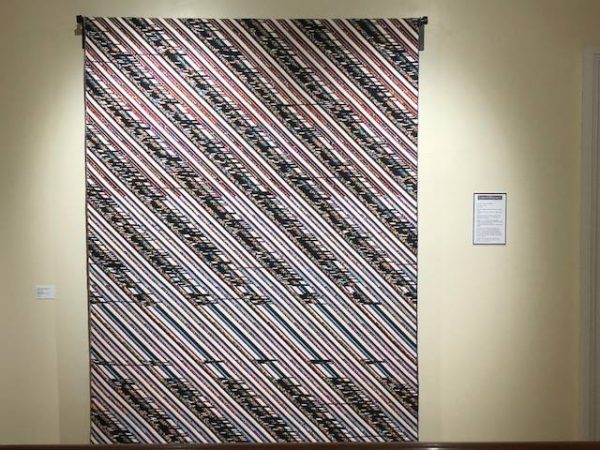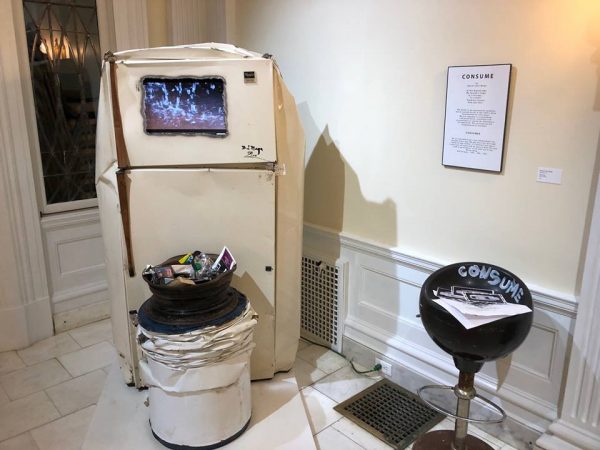A crumpled water heater. Footage of a train that looks like it’s been put through a shredder and reassembled. Halting images being projected onto a disc of celluloid film. Metal formed into an image of the factory where it was made. Crisp, evocative paintings that turn out to have been drawn via computer. Video stills of a man in various positions, rendered in ghostly blue and white. A photo of a long white table at which sit children, some mysteriously multiplied. A roiling orb projected on a screen.
These are the wonders that will greet you at the Stifel Fine Arts Center for the next several weeks. The exhibit is called Convergence: Art in the Digital Age. It brings together pieces from more than a dozen regional artists employing various media — digital painting, manipulated photography, video, 3D printing, installation — and explores art in our binary, computerized world.
The opening reception earlier this month gave guests their first chance to view the exhibit. Many of the artists attended as well; they mingled and mused along with the assembled aesthetes.
No matter when you check out the exhibit, venture upstairs and you’ll find yourself confronted by a tapestry spanning floor to ceiling and stretching wider than your correspondent’s wingspan. Stepping face to face with this textile makes you feel like a kid who’s pressed her nose to the TV on a Saturday morning in pursuit of the essence of Bugs Bunny and inadvertently discovered the little cells of color that compose televisual images. What does such a piece mean?
Backing up to take in the big picture doesn’t suddenly reveal some image you were just at the wrong perspective to recognize and that makes everything clear. Rather, taking in the piece as a whole reveals a failure to communicate: you see a smashed TV screen, with jagged lines of color dissecting it every which way.
Here perhaps is a meaning we can resolve from the ruined screen. In this piece, an attempt to communicate via a digital medium has been foiled by the breakdown of the medium itself, while a traditional medium does speak. The tapestry — both as the literal substance of the artwork and as the metaphorical frame of the TV — brings forth the message of the difficulty of communication itself.
Turning to the artist’s description provides another way in. The tapestry is by Phillip David Stearns and is called Vestigial Data. Then a definition of “vestigial” is given: “Occurring or persisting as a rudimentary or degenerate structure.” And this description appears: “Data from hidden crash recovery files are visualized to reveal startling structures and patterns. Rendered useless by interactions between incompatible operating systems and drive formats, this data maintained its presence, tucked away from sight, its former purpose now a distant memory.”

In this light, the tapestry can be seen as an appendix to our attempts to communicate in the digital age. It records these failures in cloth, thereby allowing us to examine and comment on them. Just as computers get overloaded and have to reboot, scrapping whatever processes they were running and starting over, we too come to crises and must cast aside or rethink our burdens in order to go on. This leaves scars. For us, they are physical and mental marks; for our computing companions, they’re craggy streaks across the monitor and files that cease to function.
The human and digital ordeals we can see dramatized in the tapestry indeed leave marks that “maintain their presence” and yet leave their “former purpose now a distant memory.” But perhaps this is something to embrace, not despair of. Thank heavens for forgetting. What a gift to have the searing memories of our failures fade away like so many misplaced 1’s and 0’s, forever irretrievable on an imperfect hard drive.
Explore the first floor and you might notice a heap in a corner. The battered refrigerator, water heater and car’s wheel rim are in fact David John Mega’s piece Consume. In the rim sit casualties of our technological, disposable age: a cassette tape, a cellphone (a flip phone, actually, if you were alive back then), a customer assistance pamphlet, a plastic water bottle, a camera, a shoe, a Consumer Reports magazine buying guide. Into the refrigerator’s icebox has been set a TV that plays video of the discarded items being crushed in a junkyard.
The refrigerator — once a repository of nourishment and preservation — has been transformed into a receptacle of destruction. It stands over the crushed water heater and its crown of digital detritus like a tombstone, marking the premature grave into which we consign so many still-functioning things.

Mega accompanies the work with text that bears this out: “We as consumers get crap shoved down our throats every day. We pay more for less — and taxed on top of that. If it doesn’t fall apart, it goes out of style — and we have to buy the new stuff or go without. It all ends up in the Waste Heap. And we pay… PAY… PAY… PAY.”
Indeed, we pay for our consuming and disposing habits in myriad ways every day, and some debts we are pushing off onto future generations. Shopping addiction and a fetish for novelty keep us trampling each other the day after Thanksgiving in search of a deal. And who knows what sight or sound of our world will remain if we keep expanding landfills and the garbage patches in the oceans.
Mega’s piece, then, confronts us with parts of ourselves we might rather not think about. But we must. It shows us that we can be myopic and vain and wasteful. But the piece also reminds us that we can transform the ordinary through conscious attention. Consume is a monument to the ills of society, yet it is just as much an exemplar of the power of art. By setting this seeming pile of junk before us, Mega invites us to see it in a new light, to pause and consider our consumption, to perhaps live more intentionally for having encountered this work.
The exhibit is on display through Oct. 26. The Stifel Fine Arts Center is open 9 a.m. to 5 p.m. Monday through Friday and 10 a.m. to 4 p.m. Saturday. Admission is free.
• Ryan Norman hails from a suburb of Cleveland and earned an English degree at Wheeling Jesuit University. He lives in East Wheeling where you might find him listening to Gustav Mahler or Keith Jarrett, reading David Foster Wallace or Dave Eggers, and thinking along with Martin Heidegger and Roger Scruton. Ryan is also a chorister at St. Matthew’s Episcopal Church and a member of The Prosers, a group that performs original poetry and prose at Towngate Theatre.


